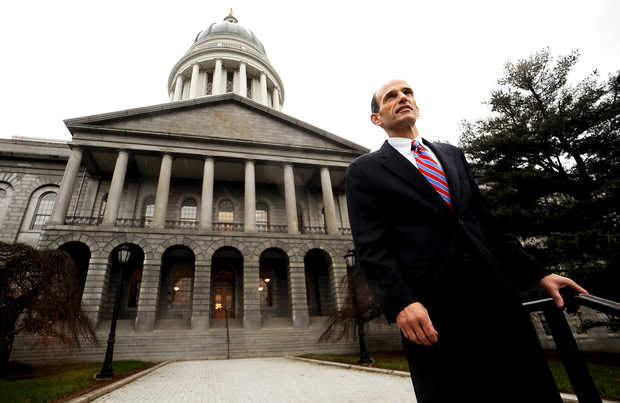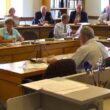A critical look at Maine’s wind act: Part 1
Editor’s note: This is part one of a three-part series on the 2008 law to fast-track wind turbine development.
The Wind Energy Act of 2008, which gave developers a fast track to putting up wind turbines in some of the state’s treasured high ground, was a special interest bill justified at the time in the name of jobs, energy independence and climate change.
“There is tremendous potential for Maine to become a leader in clean, renewable energy, including wind energy,” said Gov. John Baldacci, who appointed the task force whose report led to the bill. “This kind of investment would create jobs and help to expand Maine’s economy.”

But now, two years after the law was championed by Baldacci, some members of the task force, all of whom supported the Wind Energy Act, are questioning whether the goals they set for wind power can or even should be achieved.
Critics and even some one-time supporters say the proponents of the law were swept up in a tidal wave of enthusiasm for a technology that turns out to require significant sacrifice from the state, but has little to offer Maine in return.
That issue was faced head on recently when the state Land Use Regulation Commission (LURC) was asked to rule on a TransCanada wind project in western Maine. LURC Commissioner Ed Laverty, summed up the problem with the bill: “Our job is to protect the resources in these high mountain areas … given the fragile nature, and the rich nature of the resources in these areas, we have to ask ourselves, to what extent can these benefits really outweigh the long-term costs?
Chris O’Neil, a former state legislator who now works as a public affairs consultant to groups opposing wind power development in Maine’s mountains, said that the governor’s vision was fundamentally flawed. “To fulfill the charge of making Maine a leader in wind power development and to simultaneously protect Maine’s quality of place is impossible,” O’Neil said.
The bill constituted one of the most significant changes in the state’s land use laws in a generation:
• It weakened longstanding rules that would have required wind turbines “to fit harmoniously into the landscape.” LURC director Catherine Carroll said, “That’s a huge change.”
• The bill cut off a layer of appeal for those protesting state permits for wind power.
• It set ambitious goals for the development of wind power that could result in 1,000 to 2,000 turbines being constructed along hundreds of miles of Maine’s landscape, including the highly prized mountaintops where wind blows hard and consistently.
• It opened every acre of the state’s 400 municipalities to fast-track wind development.
Baldacci said all this could be done without hurting Maine’s landscape or the tourism industry.
The legislation was based on the report of the Governor’s Task Force on Wind Power Development, whose members all favored wind power development and who, likewise, asserted that their blueprint for wind power development would return substantial rewards and could be pursued without sacrifice. “Maine can become a leader in wind power development, while protecting Maine’s quality of place and natural resources, and delivering meaningful benefits to our economy, environment, and Maine people,” task force members wrote.
Now, as wind turbines are sprouting on Maine’s mountains accompanied by heavy machinery, roads, transmission lines, substations, wells and concrete plants, that certainty is yielding to doubt for some. “I think people didn’t have a good appreciation of this, including us, for what the whole thing entails,” said Maine Audubon’s Jody Jones, a biologist who served on the task force.
“This process was another step to better environmental policy, but there were clearly flaws.”
And members of LURC have recently indicated they’ll turn down TransCanada’s wind power development in an ecologically sensitive, high-elevation region near the Canadian border. The move was widely seen as a rebuke to the idea that wind power should be developed at all costs and enraged the developer and wind power promoters. That the unanimity behind the wind power law is breaking down does not surprise Jones.
Momentum slipping
“People live near them, projects have been built, we can touch and feel them in a way that’s not theoretical. …There isn’t the momentum for wind power at all costs that there was when the task force did its work,” Jones said.
That momentum may have papered over some significant differences among task force members that are now becoming more obvious. As they neared completion of their report on wind power development in December, 2007, Baldacci made the unusual move of sending his senior policy advisor Karin Tilberg to press task force members to issue a unanimous set of recommendations.
They did as Baldacci asked, and that unanimity, from a group whose members represented prominent environmental groups as well as wind power developers, set the stage for the bill’s unanimous passage through a legislative committee.
Once the committee passed the wind energy bill on to the full House and Senate, lawmakers there didn’t even debate it. They passed it unanimously and with no discussion. House Majority Leader Hannah Pingree, a Democrat from North Haven, says legislators probably didn’t know how many turbines would be constructed in Maine if the law’s goals were met – the number is likely to be at least 1,000 and perhaps as high as 2,000.
Instead, they got carried along in the wave of enthusiasm that emerged from the administration, the legislative committee, wind power developers and the governor’s task force. “Wind power was exciting,” says Pingree. “I think legislators had a sense we wanted to be bold and have the state be a real leader in this area — they may not have known how many turbines, or the challenges of siting that many turbines.”
And proponents of the bill’s goals say that it addressed significant problems with Maine law that hindered the development of what could be a powerful source of economic development in the state. Law professor Orlando Delogu told the task force that streamlining the regulatory burden on wind power to promote the industry in Maine could mean billions of dollars of investment and employment in the state:
“This energy source, this industry, has the capacity to infuse somewhere between $2-3 billion dollars of new capital investment into (the) Maine economy,” Delogu wrote in a paper included in the task force’s final report to the governor. “By historic standards these are staggering numbers but at the same time this is a level of investment that is clearly within reach — Maine has the critically necessary wind resource.”
Bill sponsor Sen. Phil Bartlett, a member of the wind power task force and a strong advocate of wind energy development in Maine, said in a recent interview that New England has growing power needs and new regulations that require the production of renewable power such as wind. Maine, said Bartlett, has the wind to meet that demand. But the state needed regulations that could help it swiftly feed that market.
“Maine is in a unique position because we have so much wind power potential. We’re in a position to capitalize on that to help Maine people in the region.”
Task force members roundly praise their chairman, Alec Giffen, for forging unanimity on the report that led to the legislation. They say that Maine is better off with a law that creates regulatory certainty for wind than the muddle of old regulations that led to expensive battles over siting projects. And they say that addressing, through the legislation, what the NRCM’s Pete Didisheim called the “crisis” of climate change is critical.
But an investigation by the Maine Center for Public Interest Reporting of the workings of the wind power task force through numerous interviews and a review of relevant documents reveals a number of problems with the law and its development:
• Appointing only wind power supporters to the task force and rushing the legislation through the legislature failed to address public skepticism about the state’s wind power policy. Issues that may have been aired through a Statehouse debate continue to be raised by a growing number of critics of wind power, who doubt the policy’s premises that wind power brings widespread economic benefits, moves Maine off fossil fuels or can be developed without compromising the quality of Maine’s landscape.
• Members of LURC, who review proposals for wind power development in the unorganized territory, have expressed consternation about the contradictory and perhaps unachievable goals of the Wind Power Act – to promote wind power development, ensure communities get benefits from the development and protect the very parts of the Maine landscape where wind power turbines are likely to be built.
• The designation of “expedited wind power zones” along some of the state’s wildest mountaintops has raised the value of that real estate, since it’s now a target for wind power development. That had the unintended effect of creating competition for conservationists who want to protect that land.
• The task force ignored the need for massive new transmission line construction to move wind energy from turbines to market, which could be costly to ratepayers, disrupt habitat and landscape and engender significant opposition from towns and conservation groups.
• At least one significant task force recommendation – to allow the DEP commissioner to modify permits if wind turbines made too much noise – was left out of the governor’s bill that became the wind power law.
• One of the most crucial discussions held by the task force – what lands to open to expedited wind power development – is not in the public record. There were no minutes taken or produced for those final two meetings of the task force.
Baldacci still a believer
Gov. Baldacci remains steadfast in his support of wind power. He and Tilberg refused to grant the Center an interview in person, but Baldacci responded to questions in writing: “I believe that reducing reliance on fossil fuels for energy in Maine and the region will greatly increase Maine’s quality of place by reducing carbon emissions, slowing climate change from greenhouse gases (which affects our forests, watersheds, oceans and fisheries, agriculture, wildlife and other natural resources), pushing natural gas off the margins in the bid stack and thereby reducing electricity costs, promoting energy security and self-reliance, and keeping Maine citizens’ dollars circulating in Maine and not being sent to other jurisdictions.
“For many people including myself, quality of place includes living in a manner that does not push environmental or safety risks to other places and people.”
Land-based wind power development is certainly not dead in Maine. But the wind power bandwagon that came roaring out of the Statehouse in 2008 is encountering obstacles that are slowing it down.
“Call it the bloom off the rose, call it the emperor being exposed as having no clothes,” says O’Neil. “As the public learns the truth about the impacts and the benefits of this sort of development, the public is losing its interest in industrial scale wind.”
Combine those home-grown obstacles with an increasingly tight credit market and uncertainty over continued government subsidies for the industry, and wind power development these days in Maine looks like much less of a sure thing than Baldacci, the legislature, some environmentalists and the wind industry hoped it would be just two years ago.




